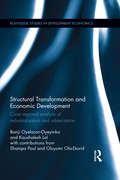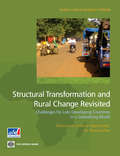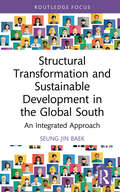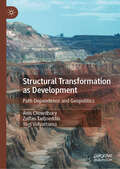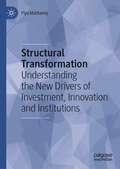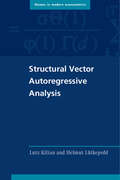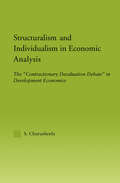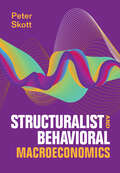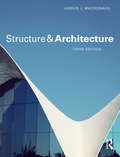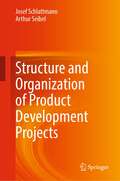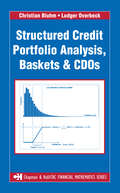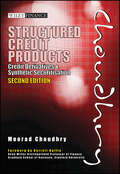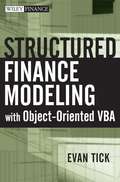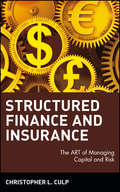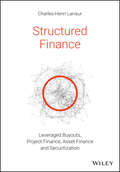- Table View
- List View
Structural Reforms: Moving The Economy Forward
by Jakob De Haan Jante ParlevlietThis book presents a selection of contributions on the timely topic of structural reforms in Western economies, written by experts from central banks, the International Monetary Fund, and leading universities. It includes latest research on the impacts of structural reforms on the market economy, especially on the labor market, and investigates the results of collective bargaining in theory and practice. The book also comprises case studies of structural reforms. A literature survey on the topic serves as a valuable source for further research. The book is written by and targeted at both academics and policy makers.
Structural Revolution in International Business Architecture, Volume 1: Modelling and Analysis
by Dipak Basu Victoria MiroshnikMost of the established theories of economics, particularly of international trade, became obsolete in the new world trade and production architecture. How, in these new circumstances, will host nations organize their economic resources? This book analyzes some prominent countries in the world to examine the issue.
Structural Transformation and Agrarian Change in India (Routledge Studies in Development Economics)
by Goran Djurfeldt Srilata SircarThe landlord and his emaciated labourer are symbolic of Indian agriculture. However, this relationship has now changed as large landowners have fallen from their superior position. This volume explores how this emblematic pair is becoming a thing of the past. Structural Transformation and Agrarian Change in India investigates whether family labour farms are gaining prominence as a consequence of the structural transformation of the economy. The authors work alongside Weberian methodology of ideal types and develop different types of family farms; among them family labour farms that rely mainly on family workers, contrasted with capitalist farms that depend on hired labour. Agriculture is shrinking as a part of the total GDP at the same time as agricultural labour is shrinking as part of the total labour force. The changing agrarian structure is explored with the use of unique long-term survey data and statistical models. Results show that India is approaching farm structures that are typical of East and South East Asia, with pluriactive smallholders as the norm. This book successfully criticizes popular narratives about Indian agricultural development as well as simplistic evolutionist, Marxist or neoclassical prognoses. It is of great importance to those who study development economics, development studies and South Asian economics.
Structural Transformation and Economic Development: Cross regional analysis of industrialization and urbanization (Routledge Studies in Development Economics)
by Banji Oyelaran-Oyeyinka Kaushalesh LalThis book examines long-term structural changes and the broad impact on economic development in regional comparative perspectives. The book analyzes data across Africa, Asia and Latin America. It looks at key variables of productivity growth, industrialization, poverty, urbanization, and employment. This book is concerned with understanding structural change dynamics and how it affects job creation, living standards, and the efficiency of productive cities through manufacturing productivity growth that benefits majority of citizens. With empirical evidence from a selected number of developing countries including China, India, Brazil, Nigeria and South Africa, the book attempts to present the considerable structural changes of these countries over the last few decades. It highlights that growth without the expected job creation is one of the distinct features of growth in emerging and developing countries. It suggests that countries may well record economic growth, whether through within sector productivity increase or through structural change, but this may not necessarily lead to employment, an important concern for long-term development.
Structural Transformation and Rural Change Revisited
by Bruno Losch Sandrine Fréguin-Gresh Eric Thomas WhiteThis book makes a compelling case for reintegrating structural issues into agricultural and rural development policies, which have for the last 30 years over-focused on short-term issues. It shows how the liberalisation of agriculture in many late developing countries has not in fact led to the development of the vibrant rural non-farm economy, nor has it led to a large-scale integration of agricultural producers into the global economy. Despite these findings, the book draws optimistic conclusions: there are a clear set of policy priorities that, if adapted to individual country contexts, can facilitate an enduring and productive rural transformation. The book is based on an in-depth seven-country study that surveyed 8,000 rural households. It specifically focuses on these households' activity and income structures in an evolving agricultural context marked by liberalisation and trends of increasing economic integration. In doing so it reviews the very different levels (and trajectories) of rural diversification among countries at various stages in the structural transformation process. Based on its investigation of existing rural realities, the book suggests several policy orientations. These include a clear need to focus on staples and family agriculture, to engage in targeted development strategies at the regional level, and to pursue a policy of 'territorial development' that promotes strong rural-urban linkages at the level of rural localities, towns and districts.
Structural Transformation and Sustainable Development in the Global South: An Integrated Approach (Routledge Explorations in Development Studies)
by Seung Jin BaekThis book investigates the relationship between sustainable development and structural transformation within international development policy. On the one hand, sustainable development is promoted as a multi-dimensional concept for achieving environmentally and socially responsible change. On the other hand, structural transformation refers to a sustained period of growth in living standards and incomes that brings sectoral change. For some, these two objectives seem at odds with each other, but this book argues that incorporating environmental initiatives into structural transformation goals in lower-income countries actually results in better results than strategies prioritising economic growth. Drawing on extensive structural equation modelling and original analysis, the book presents an innovative inclusive sustainable development framework to demonstrate the benefits of a more integrated approach to development planning, aiming for structural transformation in line with inclusive sustainable development principles. This book will be of interest to students and researchers of global development, and to policymakers within government and development organizations.
Structural Transformation as Development: Path Dependence and Geopolitics
by Anis Chowdhury Zulfan Tadjoeddin Yogi VidyattamaThis book evaluates development progress using the lens of structural transformation in four groups of developing countries: Africa’s least developed countries (LDCs), Asia’s LDCs, landlocked Central Asian countries, and Pacific small island states. The analysis presented is contextualized in the diverse economic characteristics and geopolitical landscape of the four categories of countries. In doing so, research on Africa’s LDCs emphasizes the overall picture of missed economic opportunities, while the research on Asia's LDCs focus on policy lessons. The chapter on landlocked Central Asian countries focuses more on the unique transition experience of those countries coming out from USSR hinterlands to independent states in the wake of the third wave of democratisation in the 1990s. Lastly the evaluation of Pacific small island states is very much influenced by the fate of geography for being small in size and remotely located. The diverse coverage offers readers rich varieties of structural transformation experiences and comparative development perspectives. The book is non-technical, with descriptive, narrative, and analytical approaches on comparative development, making it suitable and accessible for non-specialist audiences.
Structural Transformation of Bangladesh Economy: A South Asian Perspective (South Asia Economic and Policy Studies)
by Mustafa K. Mujeri Neaz MujeriThis book examines the theory and global evidence on structural transformation along with stylised facts and implications using, among others, a dynamic panel model, for South Asia. The characteristics of the structural transformation process in Bangladesh bring out the relevance of a comprehensive and inclusive South Asian ‘brand’ in view of the challenges of large population size, high burden of poverty, rising inequalities and its compulsion to achieve rapid and sustained inclusive development.The analysis highlights several distinct characteristics of Bangladesh’s structural transformation including changes in value added, trade, employment, productivity, formal-informal jobs, and opportunities for low-skilled workers. The book suggests that the manufacturing sector could not create the required number of jobs and generate rapid absolute and relative productivity gains in the Bangladesh economy. Although the services sector has largely led output and employment growth, services subsectors with strong labour absorptive capacity have low average productivity. Hence, growth-enhancing structural transformation led by these subsectors is likely to be less dynamic than required for rapid employment-creating growth in the economy. The book’s analysis on COVID-19 and cyclone Amphan shows that an integrated disaster and development paradigm is needed for Bangladesh. An inclusive and health and well-being focused structural transformation presents the pathway to advance the people-centred approach to development in Bangladesh through both vulnerability reduction and investments in sustainable development that would offset both known and unknown disaster threats. The key for Bangladesh is to skillfully manage the ‘developer’s dilemma’ of achieving both structural transformation in terms of large productivity gains and inclusive growth for reducing poverty and rising inequalities. This book is relevant to students, academicians and development practitioners and others interested in contemporary development.
Structural Transformation: Understanding the New Drivers of Investment, Innovation and Institutions
by Piya MahtaneyThe book presents a comprehensive and incisive analysis of Structural transformation which is among the most relevant and crucial themes of contemporary economics. Structural transformation is the edifice that is the basis of the next phase of economic transformation. The book demonstrates that structural transformation cannot be shoe horned into a single point formula, it is not merely about achieving a double-digit growth rate, nor it is achieved by an overarching emphasis on rapid technological advancement. Based on empirical evidence pertinent to developed and developing nations and present imperatives the book provides a comprehensive elucidation that structural transformation will be profoundly determined by the empirics of investment, Innovation and Institutions.
Structural Vector Autoregressive Analysis (Themes in Modern Econometrics)
by Lutz Kilian Helmut LütkepohlStructural vector autoregressive (VAR) models are important tools for empirical work in macroeconomics, finance, and related fields. This book not only reviews the many alternative structural VAR approaches discussed in the literature, but also highlights their pros and cons in practice. It provides guidance to empirical researchers as to the most appropriate modeling choices, methods of estimating, and evaluating structural VAR models. The book traces the evolution of the structural VAR methodology and contrasts it with other common methodologies, including dynamic stochastic general equilibrium (DSGE) models. It is intended as a bridge between the often quite technical econometric literature on structural VAR modeling and the needs of empirical researchers. The focus is not on providing the most rigorous theoretical arguments, but on enhancing the reader's understanding of the methods in question and their assumptions. Empirical examples are provided for illustration.
Structuralism and Individualism in Economic Analysis: The "Contractionary Devaluation Debate" in Development Economics (New Political Economy)
by S. CharusheelaThis book argues that the debates about the appropriate economic policies to follow in the developing world within the field of development economics are at heart debates about the appropriate ontology to ascribe to agents within the developing world.
Structure And Change In Economic History
by Douglass C. NorthAt the core of Professor North's investigation is the question of property rights, the arrangements individuals and groups have made through history to deal with the fundamental economic problem of scarce resources. In six theoretical chapters, Professor North examines the structure of economic systems, outlines an economic theory of the state and the ideologies that undergird various modes of economic organization, and then explores the dynamic forces such as new technologies that cause institutions to adapt in order to survive. With this analytical framework in place, major phases in Western history come under careful reappraisal, from the origins of agriculture and the neolithic revolution through the political economy of the ancient and medieval worlds to the industrial revolution and the economic transformations of the twentieth century. Structure and Change in Economic History is a work that will reshape many established explanations of the growth of the west.
Structure and Architecture
by Angus J. MacdonaldThis thoroughly updated edition of Angus J. Macdonald’s insightful book Structure and Architecture offers an in depth analysis of structural design and its relationship with architecture. It draws on clear explanations of the connections between structural form, structural performance and architectural design to explore the interface between the technical and the visual in architecture. Additional chapters in this new edition cover the fields of structural theory, structural philosophy, the contributions of prominent engineers to the evolution of Modern architecture, and the concept and practice of sustainable design. Fully illustrated, this critical appraisal of structures is a core-curriculum text for students of architecture, structural engineering and architectural history, and is also a valuable resource for practitioners of these disciplines.
Structure and Changes of China’s Financial System (China Perspectives)
by Jie ZhangBy virtue of several theoretical models and hypotheses, this book is one of the earliest studies which systematically investigates the structure and changes of China’s financial institutions. To begin with, it examines the relation between state utility function and China’s economic growth, and reveals the formation and transition of China’s state-owned financial institutional arrangements. Based on this analysis, the author studies the influence of monetization on the arrangements, and the financial support to China’s gradual reform which have long been neglected by researchers. Also, the model of money demand that can explain the specific conditions of the gradual reform is built, as the neoclassical framework has been incapable of explaining China’s financial performance. In the last chapter, it discusses the dilemma of property rights under the state-owned financial system, with the establishment of the credit equilibrium model and the dual model of bad debts. With insightful theoretical analysis and empirical researches, this book will appeal to scholars and students in finance, economics and economic history.
Structure and Organization of Product Development Projects
by Josef Schlattmann Arthur SeibelThis book conveys useful knowledge, skills and behaviour that an engineer who is responsible for product development/project management often needs, but which is not given enough attention in the usual engineering education. It goes beyond the specialist knowledge into the human domain, because technical and/or organisational difficulties are in fact always based on human problems. The book is aimed at professionals and managers working in the development of machines, apparatus, equipment and the like, including the responsible organizational managers.
Structure and Strategy
by Robert S. Kaplan David P. NortonThe Balanced Scorecard must reflect the structure of the organization for which the strategy has been formulated. This chapter illustrates the development of scorecards for organizations that are structurally different from the autonomous business unit, from joint ventures to nonprofit and governmental enterprises. This chapter was originally published as chapter 8 of "The Balanced Scorecard: Translating Strategy into Action."
Structure, Audience and Soft Power in East Asian Pop Culture
by Chua Beng HuatEast Asian pop culture can be seen as an integrated cultural economy emerging from the rise of Japanese and Korean pop culture as an influential force in the distribution and reception networks of Chinese language pop culture embedded in the ethnic Chinese diaspora. Taking Singapore as a locus of pan-Asian Chineseness, Chua Beng Huat provides detailed analysis of the fragmented reception process of transcultural audiences and the processes of audiences' formation and exercise of consumer power and engagement with national politics. In an era where exercise of military power is increasingly restrained, pop culture has become an important component of soft power diplomacy and transcultural collaborations in a region that is still haunted by colonization and violence. The author notes that the aspirations behind national governments' efforts to use popular culture is limited by the fragmented nature of audiences who respond differently to the same products; by the danger of backlash from other members of the importing country's population that do not consume the popular culture products in question; and by the efforts of the primary consuming country, the People's Republic of China to shape products through co-production strategies and other indirect modes of intervention.
Structure: Shaping the Innovation Funnel--Designing Innovation Tournaments That Will Work for Your Business
by Christian Terwiesch Karl T. UlrichOrganizations use innovation tournaments to narrow a pool of many opportunities down to the exceptional few that can become profitable innovations. The authors offer a funnel as a useful representation of this process. As you consider the shape of your company's funnel, you should ask yourself: how wide should its mouth be? How many raw opportunities should be considered for every innovation launch to market? How aggressively should the neck of the funnel be tapered--should raw opportunities be filtered immediately, or allowed to survive through many rounds? To what extent should innovation tournaments be run as pure cascades, with opportunities flowing strictly in one direction? This chapter tackles these questions. This chapter was originally published as chapter 9 of "Innovation Tournaments: Creating and Selecting Exceptional Opportunities."
Structured Credit Portfolio Analysis, Baskets and CDOs (Chapman and Hall/CRC Financial Mathematics Series)
by Ludger Overbeck Christian BluhmThe financial industry is swamped by credit products whose economic performance is linked to the performance of some underlying portfolio of credit-risky instruments, like loans, bonds, swaps, or asset-backed securities. Financial institutions continuously use these products for tailor-made long and short positions in credit risks. Based on a stead
Structured Credit Products: Credit Derivatives and Synthetic Securitisation (Wiley Finance #723)
by Moorad ChoudhryUpdated coverage of structured credit products with in-depth coverage of the latest developments Structured credit products are one of today's fastest growing investment and risk management mechanisms, and a focus of innovation and creativity in the capital markets. The building blocks of these products are credit derivatives, which are among the most widely used products in finance. This book offers a succinct and focused description of the main credit derivative instruments, as well as the more complex products such as synthetic collateralized debt obligations. This new edition features updated case studies from Europe and Asia, the latest developments in synthetic structures, the impact of the subprime meltdown, along with models and teaching aids. Moorad Choudhry returns with this excellent update of the credit derivatives market. The second edition of his classic work is, like the subject matter itself, at the forefront of the financial industry. It deserves a wide readership. —Dr Didier Joannas Regional Director, Thomson Reuters, Hong Kong This is the perfect companion for both experienced and entry level professionals working in the structured credit fraternity. It is an erudite, insightful and enjoyable read that successfully demystifies one of the most topical subject areas in banking today, while also providing important practical examples that link the theory to the job itself. —Dr James Berriman Global Pricing Unit, Royal Bank of Scotland Moorad Choudhry has earned a deserved reputation from both academics and practitioners as one of the leading practical yet rigorous authors of finance books. In this Second Edition, his practical knowledge of credit derivatives keeps the audience engaged with straightforward explanations of complicated structures, and an accessible level of mathematical sophistication necessary to understand structured credit products. The author offers complete, rigorous analysis while avoiding overuse of mathematical formulas and carefully balanced practical and theoretical aspects of the subject. I strongly recommend this book for those wishing to gain an intuitive understanding of structured credit products, from practitioners to students of finance! —Mohamoud Barre Dualeh Senior Product Developer, Abu Dhabi Commercial Bank, UAE This is THE book for credit derivative trading. From first steps to advanced trading strategies, this is invaluable. Well written and insightful, perfect for ad hoc reference or reading cover to cover. —Andrew Benson ETF Market Making, KBC Peel Hunt, London Professor Choudhry has inspired me to really get into credit derivatives. It’s great to be lectured by someone with such energy and practical hands-on experience, as well as the ability to get stuck into the details. —George Whicheloe Equity-Linked Technology, Merrill Lynch, London Moorad Choudhry is Head of Treasury at Europe Arab Bank plc in London. He is a Visiting Professor at the Department of Economics at London Metropolitan University.
Structured Finance
by Stefano Caselli Stefano GattiFirst comprehensive book on all structured finance products Complete information on technical features, roles played by intermediaries, market in terms of demand and offer Clear structure of the book makes it suitable as a textbook for students and as a reference book for practitioners
Structured Finance Modeling with Object-Oriented VBA
by Evan TickA detailed look at how object-oriented VBA should be used to model complex financial structuresThis guide helps readers overcome the difficult task of modeling complex financial structures and bridges the gap between professional C++/Java programmers writing production models and front-office analysts building Excel spreadsheet models. It reveals how to model financial structures using object-oriented VBA in an Excel environment, allowing desk-based analysts to quickly produce flexible and robust models. Filled with in-depth insight and expert advice, it skillfully illustrates the art of object-oriented programming for the explicit purpose of modeling structured products. Residential mortgage securitization is used as a unifying example throughout the text.
Structured Finance and Insurance
by Christopher L. CulpPraise for Structured Finance & Insurance"More and more each year, the modern corporation must decide what risks to keep and what risks to shed to remain competitive and to maximize its value for the capital employed. Culp explains the theory and practice of risk transfer through either balance sheet mechanism such as structured finance, derivative transactions, or insurance. Equity is expensive and risk transfer is expensive. As understanding grows, and, as a result, costs continue to fall, ART will continue to replace equity as the means to cushion knowable risks. This book enhances our understanding of ART."--Myron S. Scholes, Frank E. Buck Professor of Finance, Emeritus, Graduate School of Business, Stanford University"A must-read for everyone offering structured finance as a business, and arguably even more valuable to any one expected to pay for such service."--Norbert Johanning, Managing Director, DaimlerChrysler Financial Services"Culp's latest book provides a comprehensive account of the most important financing and risk management innovations in both insurance and capital markets. And it does so by fitting these innovative solutions and products into a single, unified theory of financial markets that integrates the once largely separate disciplines of insurance and risk management with the current theory and practice of corporate finance."--Don Chew, Editor, Journal of Applied Corporate Finance (a Morgan Stanley publication)"This exciting book is a comprehensive read on alternative insurance solutions available to corporations. It focuses on the real benefits, economical and practical, of alternatives such as captives, rent-a-captive, and mutuals. An excellent introduction to the very complex field of alternative risk transfer (ART)."--Paul Wohrmann, PhD, Head of the Center of Excellence ART and member of theExecutive Management of Global Corporate in Europe, Zurich Financial Services"Structured Finance and Insurance transcends Silos to reach the Enterprise Mountaintop. Culp superbly details integrated, captive, multiple triggers and capital market products, and provides the architectural blueprints for enterprise risk innovation."--Paul Wagner, Director, Risk Management, AGL Resources Inc.
Structured Finance: Leveraged Buyouts, Project Finance, Asset Finance and Securitization
by Charles-Henri LarreurComprehensive coverage of all major structured finance transactions Structured Finance is a comprehensive introduction to non-recourse financing techniques and asset-based lending. It provides a detailed overview of leveraged buyouts, project finance, asset finance and securitisation. Through thirteen case studies and more than 500 examples of companies, the book offers an in-depth analysis of the topic. It also provides a historical perspective of these structures, revealing how and why they were initially created. Instruments within each type of transaction are examined in detail, including Credit Default Swaps and Credit Linked Notes. A presentation of the Basel Accords offers the necessary background to understand the regulatory context in which these financings operate. With this book, readers will be able to: Delve into the main structured finance techniques to understand their components, mechanisms and how they compare Understand how structured finance came to be, and why it continues to be successful in the modern markets Learn the characteristics of financial instruments found in various structured transactions Explore the global context of structured finance, including the regulatory framework under which it operates Structured Finance provides foundational knowledge and global perspective to facilitate a comprehensive understanding of this critical aspect of modern finance. It is a must-read for undergraduate and MBA students and finance professionals alike.



